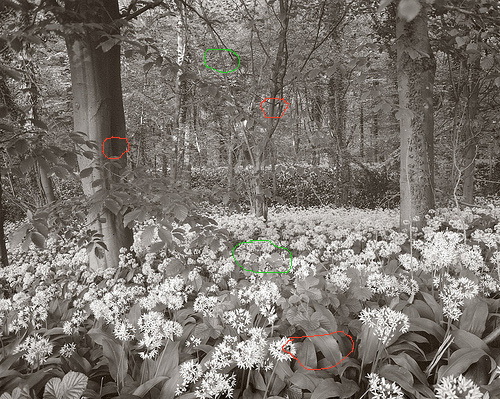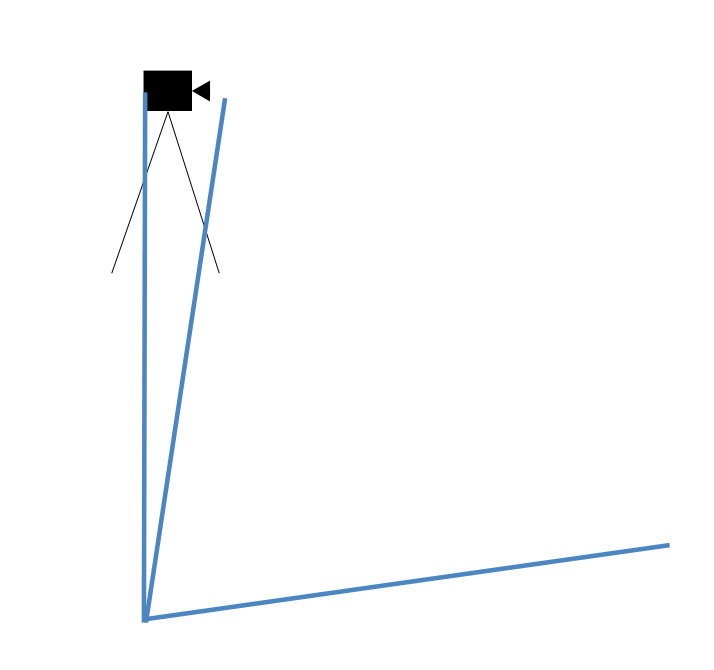
90mm/F6.8 Angulon 4sec @f22


I could well be be wrong with this (but I did run it past Tim Parkin a couple of weeks ago!), but my understanding is that the DOF calculators are generally set for the appearance of in focus with an 8"x10" print viewed from 25cms by someone with 2020 vision. I've just checked using DOFMaster and with setting the format to 4x5, lens 80mm, aperture F/32 I get the near limit at hyperfocal distance at 104cms. A little different from 95cms, but in the same area approximately.Nigels wrote:Agree with Dave_w - Tilting won't gain you anything. I'd be using my 80mm and using my DOF calculator reckon I can focus from 94.9cms to Infinity at f/32. (calculator is DoF Plus app on the iPhone)
Hi Joanne,Joanna Carter wrote:Hi Patrick
Well, I would try two different approaches, depending on the focal length of the lens.
If you look for the red marks on the image, you can always try using front forward tilt, focusing from just below the heads of the flowers in the foreground to either halfway up the tree trunk on the left or halfway up the thin tree just right of centre, then stopping down, ensuring that the ground in the dip after the main carpet of flowers is in focus.
If you look for the green marks on the image, they are meant to, approximately, represent the plane of focus you would get if you put on the tiniest possible amount of front forward tilt. And I do mean as little as is humanly possible to achieve, theoretically 0.006°. This should give you a depth of field of around 80+°, which you need to centre around a plane of of focus at around 40° from the horizontal. The plane of focus should leave the ground around 2-3 metres in front of you (represented by the green mark about 6 flowers back) and then rising to somewhere in the middle-distant canopy.
This latter "micro-tilt" technique is very effective at giving you a very large wedge of focus but it does take some time getting used to imagining the angles and finding the best angle to ensure that neither the ground in the distance nor the top of the foremost trees lose focus. You can usually get away with around f/22 to f/32 instead of having to stop right the way down to f/45 to f/64.
The trick with micro-tilt is to check, with no (official) tilt, whether you have "normal" focusing or whether you can make out a tilted plane. If you can already see that "line" of focus, then you may already have enough tilt on the front standard, just check that it is forward tilt, not backward.Patrick Dixon wrote:I doubt the front and rear standards are aligned to 0.1 degree (or better) ... so it all seems a bit academic.
I don't want to end up looking like Tiger Woods at the Open, with books and charts to consult and a caddy to advise and carry all the stuff, so I guess it's just a matter of picking two points and trying to get them in focus at the same time.
Patrick Dixon wrote:I doubt the front and rear standards are aligned to 0.1 degree (or better) ... so it all seems a bit academic.
I don't want to end up looking like Tiger Woods at the Open, with books and charts to consult and a caddy to advise and carry all the stuff, so I guess it's just a matter of picking two points and trying to get them in focus at the same time.

Tim's diagram seems to show the DOF at a fairly large aperture. When you get to around f/22, you actually start to see a much larger angle.Patrick Dixon wrote:Hmm.
What Tim's diagram says to me, is that I have no chance of focusing this scene @f22!
If my near focus point is <1m and close to the ground, and I also need to cover about 4m high 4m away, but still have ground level at infinity covered - I need more, rather than less, tilt.
If I used 1deg (blue), but pulled the focus point in, I'd probably be OK for the first two, but the ground level beyond a couple of meters would OOF.
Is this why everyone just goes with a rock in foreground and a mountain & sunset in the upper third then?

